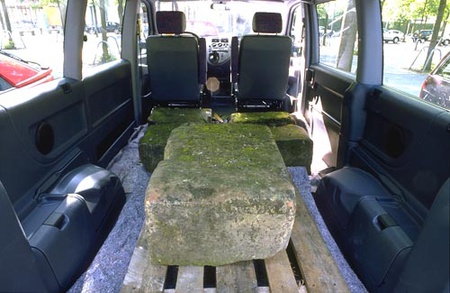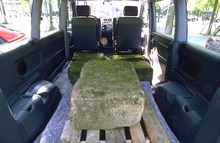Kurt Ryslavy
Verkaufswerk Nr. 17 [Work for Sale #17]
1995/96
Installation consisting of: Mercedes Vito 110 D delivery van (metallic Bordeaux), three marlstone sculptures by Georg Herold from “Symposion Alleen de verandering houdt stand” (Meerssen/NL 1987), small pallets, parking permit, certificate
Location
Parking area on the southwest side of Domplatz in front of the Westfälisches Landesmuseum für Kunst und Kulturgeschichte, Münster.
Temporary installation for the duration of Skulptur. Projekte in Münster 1997
Further works exhibited in the museum:
Verkaufswerk Nr. 1, 1993 (with a work by Dieter Roth, 1982)
Verkaufswerk Nr. 3, 1993 (with a work by Martin Kippenberger, 1987)
Verkaufswerk Nr. 5, 1992–1997 (with a work by Franz West, 1983/1984)
Verkaufswerk Nr. 9, 1994 (with a work by Dieter Roth, 1982)
Verkaufswerk Nr.10, 1994 (with a work by Franz West, 1979/1980)
Verkaufswerk Nr. 13, 1994 (with two works by Franz West, 1980/1981)
Kurt Ryslavy
* 1961 in Judendorf-Straßengel, Austria
lives and works in Brussels, Belgium
On the southwest side of Domplatz in front of the Westfälisches Landesmuseum für Kunst und Kulturgeschichte Kurt Ryslavy parked a small red delivery van. Placed on small pallets in the van’s cargo area were three stone sculptures by the artist Georg Herold. Behind the windscreen of the registered and roadworthy vehicle was a parking permit and a certificate documenting the provenance of the sculptures and confirming the authenticity of Ryslavy’s Verkaufswerk Nr. 17. Earlier Verkaufswerke were shown inside the museum in a more comprehensive presentation of the series.1
Ryslavy’s concept for the series evolved after several exchange transactions between befriended artists such as Georg Herold, Franz West, Martin Kippenberger and Dieter Roth in the early 1980s. On moving to Brussels in 1987 the Austrian artist was unable to find adequate storage space for the exchanged artworks. In the run-up to a group exhibition in 1992 in the art venue Opus Operandi in Ghent the display space that had originally been promised to Ryslavy was steadily reduced. In response to this the artist developed the principle of the Verkaufswerke.2 Ryslavy put up for sale the artwork by a colleague together with a container made especially for its transport and all necessary documents.
Kurt Ryslavy countered the lack of appreciation shown towards his works by commercialising the exhibition context. To visitors he presented the (im)material act of buying as the work of art and, accordingly, the artist as a dealer.
Daniel Friedt
1 For more information on Ryslavy’s Verkaufswerke exhibited in the museum, see: Klaus Bußmann, Kasper König and Florian Matzner (eds.), Skulptur. Projekte in Münster 1997, exhib. cat. Westfälisches Landesmuseum für Kunst und Kulturgeschichte, Münster, Ostfildern-Ruit, 1997, p. 361.
2 See Kurt Ryslavy, “Zur Geschichte der ‘Verkaufswerke’”, available online at:
http://www.ryslavy.com/textsforGRfr02/artist_articles/GeschichteVerkaufswe.html (last consulted: 13.04.2017).
Location
- Still existing / Public Collection
- Removed
- In the museum

